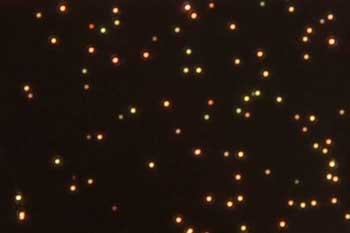| Nov 29, 2018 | |
Quickly capture tiny particles reacting(Nanowerk News) When photographing a crowd, photographers often focus in on a single detail or the whole crowd. The close-up image offers exquisite details. The wide shot shows the environment. Scientists working on light-emitting nanoparticles want both. They want high-resolution images of a group of particles as the particles react and they want to zoom in on each particle. |
|
| They devised a new system that captures images of the particles as well as information about the light emitted every millisecond (Journal of Physical Chemistry C, "Snapshot hyperspectral imaging (SHI) for revealing irreversible and heterogeneous plasmonic processes"). | |
 |
|
| If you put these tiny particles under a standard microscope, they’d look identical. However, a new system shows just how different the particles are in terms of size, shape, and light scattered. The system takes snapshots of particles and the light they scatter or emit when excited. The images can show how particles change during chemical reactions. (Image: Rice University) | |
| The data gathered from this new technique could help industries fine-tune nanoparticles that capture and use light. For example, it could help with plasmonic catalysts. These materials use energy from sunlight to drive chemical reactions. | |
| That is, the particles use light to make reactions faster and/or more efficient. Understanding how the particles react and change would help create plasmonic catalysts that improve solar panels and petrochemical processing. | |
| Easily tuned nanometer-sized crystals that absorb and react with light with extreme sensitivity would aid both petrochemical and solar energy industries. During the processing and production, these particles often change. These changes occur in an instant and can significantly affect how the particles perform. | |
| Conventional methods are too slow to capture the changes. Now, scientists at Rice University devised a faster way to get the picture. Their method, called snapshot hyperspectral imaging, offers exquisite detail of groups of particles. | |
| The team’s method aligns a microscope, two camera systems, a specialized laser, and a diffraction grating. | |
| The resulting system gathers data about the particles of interest in an instant. With the system, the team observed, for the first time, an electrochemical surface reduction-oxidation reaction for gold nanoparticles at the microsecond time scale. | |
| In the future, scientists may enhance the snapshot hyperspectral imaging system to capture images of nanoparticles as they grow. |
| Source: U.S. Department of Energy, Office of Science | |
|
Subscribe to a free copy of one of our daily Nanowerk Newsletter Email Digests with a compilation of all of the day's news. |
